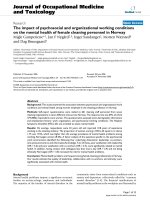BULLYING ROLES AND ASSOCIATIONS WITH MENTAL HEALTH OF ADOLESCENTS IN VIETNAM a SHORT TERM LONGITUDINAL STUDY
Bạn đang xem bản rút gọn của tài liệu. Xem và tải ngay bản đầy đủ của tài liệu tại đây (8.25 MB, 273 trang )
BULLYING ROLES AND ASSOCIATIONS WITH
MENTAL HEALTH OF ADOLESCENTS IN VIETNAM: A
SHORT-TERM LONGITUDINAL STUDY
HA HAI THI LE, BA, MA
Submitted in fulfilment of the requirements for the degree of
Doctor of Philosophy of Public Health
School of Public Health and Social Work
Faculty of Health
Queensland University of Technology
2017
ii
Abstract
Bullying is a public health concern because this type of interpersonal aggression
among adolescents is common and has substantial impact on mental health and wellbeing.
Although numerous studies on bullying have been conducted in Western countries, there
has been relatively limited research in bullying with standardised measurement in the SouthEast Asian region. Moreover, few longitudinal studies have measured both traditional
bullying and cyberbullying to examine the change in bullying roles and the prospective
influence of this change on health.
Research objectives: This thesis was conducted to address four research objectives:
1. Examine the prevalence of various forms of traditional and cyberbullying
victimisation and perpetration among school adolescents in Vietnam.
2. Examine temporal patterns of bullying roles (as a victim, bully, or bully-victim) among
school adolescents over two time points.
3. Examine potential determinants (individual characteristics and family, school, and
peer relationships) of temporal patterns of bullying roles over time.
Examine longitudinal associations between temporal patterns of bullying roles across
two time points and mental health problems among adolescents (including depressive
symptoms, psychological distress, and suicidal ideation).
Research designs: This study employed a mixed methods approach and a shortterm longitudinal survey design. The study was conducted in Hanoi and Hai Duong province
in northern Vietnam across an academic year 2014–15. The research included four phases:
1. Qualitative research. In-depth interviews (IDIs) with 16 students in four schools
(including two middle schools and two high schools) were conducted to explore the
perceptions and experiences of students about traditional bullying and
cyberbullying.
iii
2. Pilot survey. This was conducted with 226 students (56.7% female, age range 12–17
years, mean [SD]: 14.5 [1.6]) in two schools. The qualitative interviews plus the pilot
survey guided development of a standardised quantitative survey instrument to
measure bullying victimisation and perpetration.
3. Baseline survey (Time 1). The baseline survey was conducted with 1424 middle and
high school adolescents (54.9% females, age range 12–17 years, mean [SD]: 14.7
[1.9]).
4. Follow-up survey (Time 2). Students who participated in the baseline survey were
invited to the follow-up survey, six months later. The longitudinal design enabled
estimation of temporal stability or change in bullying roles as a victim, bully, or bullyvictim. It also enabled analyses of determinants of the stability in bullying roles over
time, and the effects of stability or change on mental health among adolescents.
Results
The findings from baseline and follow-up surveys indicated that traditional bullying
(including victimisation and perpetration) is more common than cyberbullying among
Vietnamese school adolescents at both Time 1 and Time 2. The correlations between
traditional victimisation and cyberbullying victimisation and between traditional bullying
perpetration and cyberbullying perpetration are very high. The large majority of students
who experienced cyberbullying (about 81% for victims, 75% for bullies, and 100% for bullyvictim) did so in conjunction with traditional bullying. There were only 17 students who were
involved in cyberbullying victimisation or perpetration.
Analyses of bullying victimisation and perpetration over Time 1 and Time 2 show six
in ten students (61%) were engaged in bullying roles as victim, bully, or bully-victim during
one academic year. Of these students, nearly three in four (74%) indicated unstable bullying
roles. The temporal patterns of bullying roles over time were captured as follows: (i) 554
students (38.9%) were not involved in any form of bullying at both times; (ii) 342 students
(24%) were victims only (of them, 52% were stable-low, 17.0% declining, 14.3% increasing,
and 10.5% stable-high); (iii) 94 students (6.6%) were bullies only (of them, 23.4% were stablelow, 36.2% declining, and 40.4% increasing or stable-high); (iv) 434 students were bullyiv
victims (of those, 52.8% were stable-low, 19.3% declining, 14.5% increasing, and 13.4%
stable-high).
Analyses of determinants of temporal patterns of bullying roles found that gender,
age, and mental health were significantly associated with victimisation and bully-victim
status over time, indicating that younger male students with poorer mental health
(depressive symptoms, psychological distress) had higher odds of being in victim only or
bully-victim roles. In contrast, there were no significant correlations between gender, age,
and mental health status among those students who only bully others.
The effects of family environment were observed among all bullying roles. Those who
were not living with both biological parents, frequently witnessed parental violence, or
experienced conflict with their siblings had significantly higher odds of frequent involvement
in perpetration and bully-victim status at Time 1 or Time 2. Low parental supervision of
online activities increased the odds of being victimised, and a high degree in parental control
of the respondents’ mobile phone/Internet access decreased the odds of frequent
involvement in bully-victim activity at Time 1, compared with the not-involved group.
Peers’ reaction towards bullying was significantly associated with bullying roles.
Specifically, those who perceived that students do not try to stop bullying at school had
significantly higher odds of being victimised at a low level over time or a high level at Time
1. Meanwhile, those who supported the bullies and thought bullying is acceptable increased
the odds of being frequently involved in bully-victim behaviours. Adolescents who witnessed
bullying events at school regardless of their roles as bystanders (such as passively witnessed
bullying event, did nothing but thought they ought to help the victims, or tried to stop
bullying) had higher odds of having bully-victim status at one-time point or both times.
The analyses of longitudinal associations between temporal patterns of bullying roles
and mental health problems show those students, who were victimised often and classified
as highly involved as both victims and bullies at one or both survey times (i.e., declining,
increasing, and stable-high), had significantly higher levels of depressive symptoms,
psychological distress, and suicidal ideation than those who were not involved or had stablelow involvement. The mental health of adolescents, who were involved in bullying as a victim
v
or bully at stable-low, was generally similar to those not involved in any bullying. However,
females who experienced stable but low-level victimisation or the bully-victim role had
worse mental health than males with stable-low level exposure.
Implications: This study has implications for preventive interventions for bullying
in Vietnamese schools and internationally.
The dominance of traditional bullying and high correlations between traditional
bullying and cyberbullying indicated that cyberbullying rarely occurs in isolation from
traditional forms. Preventive intervention should address all forms of bullying rather than
focus heavily on the online environment. Anti-bullying programs should include components
on cyberbullying within the context of broader efforts to prevent interpersonal conflict and
violence.
Although popular perception suggests that children tend to be either a bully or a
victim and the behaviours are stable over time, research shows a more complex picture. The
findings of this study show a high degree of fluidity in bullying roles as victim, bully, or bullyvictim over an academic year. The main implication of this key finding is that bullying
prevention should seek to change whole-of-school culture that tolerates interpersonal
aggression by promoting mutual respect. Parents and family members need to be engaged
as a part of anti-bullying efforts and be educated to recognise the impact of their own
behaviours and home environment. A minority of youth appear to be stable, high intensity
bullies or victims, and these students may require special intervention and support.
This study’s findings indicate that mental health problems (depressive symptoms and
psychological distress) can be both determinants and consequences of victimisation and
bully-victim roles. Anti-bullying programs should be a core element of mental health
promotion in schools rather than addressed in standalone programs.
vi
Keywords
Adolescents, Cyberbullying, Depression, Longitudinal study, Mental health,
Psychological distress, School-based survey, School adolescents, Suicidal ideation,
Traditional bullying, Victimisation, Vietnam
vii
viii
Table of contents
ABSTRACT ............................................................................................................................ III
KEYWORDS.......................................................................................................................... VII
TABLE OF CONTENTS ............................................................................................................. IX
LIST OF TABLES ..................................................................................................................... XI
LIST OF FIGURES ................................................................................................................. XIII
LIST OF ABBREVIATIONS....................................................................................................... XIV
STATEMENT OF ORIGINAL AUTHORSHIP .................................................................................. XV
RELATED PUBLICATIONS AND PRESENTATIONS ..................................................................... XVII
ACKNOWLEDGEMENTS......................................................................................................... XIX
CHAPTER 1:
INTRODUCTION ............................................................................................ 1
1.1
RATIONALE .................................................................................................................... 1
1.2
RESEARCH OBJECTIVES ................................................................................................. 3
1.3
SIGNIFICANCE OF THE STUDY .......................................................................................... 3
1.4
THESIS OUTLINE............................................................................................................. 4
CHAPTER 2:
LITERATURE REVIEW.................................................................................. 7
2.1
WHAT IS BULLYING? ....................................................................................................... 7
2.2
WHAT IS ALREADY KNOWN ABOUT BULLYING? ................................................................ 10
2.3
FACTORS ASSOCIATED WITH BULLYING ROLES ............................................................... 24
2.4
THE ASSOCIATIONS BETWEEN BULLYING AND MENTAL HEALTH ........................................ 32
2.5
STUDIES ON BULLYING IN VIETNAM................................................................................ 35
2.6
THE NEED FOR LONGITUDINAL STUDY: WHAT IS STILL UNKNOWN? ................................... 36
CHAPTER 3:
RESEARCH DESIGN ................................................................................... 39
3.1
INTRODUCTION ............................................................................................................ 39
3.2
CONCEPTUAL FRAMEWORK OF THIS STUDY .................................................................... 39
3.3
RESEARCH DESIGN ...................................................................................................... 41
3.4
STUDY SITES ............................................................................................................... 44
3.5
ETHIC APPROVALS ....................................................................................................... 45
3.6
STUDY PARTICIPANTS................................................................................................... 45
3.7
TIMELINES ................................................................................................................... 47
3.8
INSTRUMENT DEVELOPMENT ......................................................................................... 47
3.9
DATA COLLECTION PROCEDURES .................................................................................. 54
3.10
DATA MANAGEMENT AND ANALYSES .......................................................................... 55
3.11
FINDINGS FROM EXPLORATORY QUALITATIVE RESEARCH ............................................ 57
3.12
FINDINGS FROM THE PILOT SURVEY .......................................................................... 65
3.13
RELIABILITY AND VALIDITY OF BULLYING VICTIMISATION AND PERPETRATION SCALES
ix
... 75
CHAPTER 4:
PREVALENCE AND TEMPORAL PATTERNS OF BULLYING ROLES
OVER TIME 1 AND 2 ................................................................................... 89
4.1
INTRODUCTION ............................................................................................................ 89
4.2
DATA ANALYSES........................................................................................................... 89
4.3
CHARACTERISTICS OF RESPONDENTS ........................................................................... 90
4.4
PREVALENCE OF BULLYING ROLES ................................................................................ 94
4.5
THE OVERLAP BETWEEN BULLYING ROLES ................................................................... 102
4.6
TEMPORAL PATTERNS OF BULLYING ROLES OVER TIME 1 AND TIME 2
4.7
SUMMARY.................................................................................................................. 106
CHAPTER 5:
............................ 103
DETERMINANTS OF TEMPORAL PATTERNS OF BULLYING ROLES 109
5.1
INTRODUCTION .......................................................................................................... 109
5.2
ANALYTICAL FRAMEWORK ........................................................................................... 110
5.3
DATA ANALYSES......................................................................................................... 110
5.4
DETERMINANTS OF TEMPORAL PATTERNS OF VICTIMISATION......................................... 112
5.5
DETERMINANTS OF TEMPORAL PATTERNS OF PERPETRATION
5.6
DETERMINANTS OF TEMPORAL PATTERNS OF BULLY-VICTIM STATUS.............................. 120
CHAPTER 6:
....................................... 116
LONGITUDINAL ASSOCIATIONS BETWEEN TEMPORAL PATTERNS
OF BULLYING ROLES AND MENTAL HEALTH AMONG ADOLESCENTS .. 129
6.1
INTRODUCTION .......................................................................................................... 129
6.2
FRAMEWORK ANALYSIS AND METHODS ........................................................................ 132
6.3
BIVARIATE ASSOCIATIONS ........................................................................................... 138
6.4
MULTIVARIATE ASSOCIATIONS ..................................................................................... 139
6.5
SUMMARY.................................................................................................................. 142
CHAPTER 7:
7.1
DISCUSSION AND CONCLUSIONS ......................................................... 143
BULLYING FORMS AND CORRELATIONS BETWEEN TRADITIONAL BULLYING AND
CYBERBULLYING
........................................................................................................ 143
7.2
THE PREVALENCE OF BULLYING ROLES ........................................................................ 146
7.3
THE TEMPORAL PATTERNS OF BULLYING ROLES ........................................................... 148
7.4
DETERMINANTS OF BULLYING ROLES OVER TWO TIME POINTS ....................................... 149
7.5
THE LONGITUDINAL ASSOCIATIONS BETWEEN BULLYING ROLES AND MENTAL EHALTH ..... 152
7.6
STRENGTHS AND WEAKNESS OF THIS STUDY
7.7
IMPLICATIONS FOR FURTHER RESEARCH AND INTERVENTION PROGRAMS ...................... 155
............................................................... 154
REFERENCES ..................................................................................................................... 161
APPENDICES ...................................................................................................................... 179
x
List of tables
Table 2-1 Stability and changes in bullying roles over time among longitudinal studies ..................... 20
Table 3-1 The proportions of students participating in the Time 1 and Time 2 surveys at each of the four
schools ................................................................................................................................. 46
Table 3-2 Sample size in the four phases of the study ......................................................................... 47
Table 3-3 Demographic characteristics of the pilot sample ................................................................. 65
Table 3-4 Time spent online in the last week ................................................................................... 68
Table 3-5 Parent’ and teachers’ supervision and control of mobile phone usage and the Internet .... 69
Table 3-6 Mean, standard deviation and reliability statistics of perceived family, friend, and school social
support ................................................................................................................................ 70
Table 3-7 Prevalence of specific forms of bullying victimisation and perpetration ............................. 71
Table 3-8 Prevalence of specific bullying victimisation behaviours by modes of communication ....... 72
Table 3-9 Prevalence of bullying roles by gender and age ................................................................... 72
Table 3-10 Associations between bullying roles and mental health and self-harm behaviours . 73
Table 3-11 List of behaviours of the bullying victimisation and bullying perpetration scales .............. 78
Table 3-12 Correlation matrix of items in the bullying victimisation scale .......................................... 80
Table 3-13 The factor loadings of the items in bullying victimisation scale ......................................... 82
Table 3-14 Correlations between bullying victimisation and asscociated factors ................................ 83
Table 3-15 Correlation matrix in items in the bullying perpetration scale ........................................... 84
Table 3-16 The factor loadings of the items in bullying perpetration scale ......................................... 86
Table 4-1 Demographic characteristics of the sample measured at Time 1 ........................................ 90
Table 4-2 Characteristics of family measured at Time 1....................................................................... 91
Table 4-3 Prevalence of specific victimsation behaviours by frequency at Time 1 and Time 2 ........... 95
Table 4-4 Prevalence of traditional bullying victimisation and cyberbullying victimisation experiences at
Time 1 and Time 2 (%) ......................................................................................................... 97
Table 4-5 Prevalence of specific bullying perpetration behaviours by frequency at Time 1 and Time
2 ........................................................................................................................................... 98
Table 4-6 Prevalence of traditional bullying perpetration and cyberbullying perpetration experiences at
Time 1 and Time 2 (%) ......................................................................................................... 99
Table 4-7 Four main bullying roles among 1424 school adolescents (Times 1&2) and Time 2 .......... 104
Table 4-8 Associations between bullying roles at Time 1 and becoming a victim, bully, bully-victim at
Time 2 (n=1,424) ................................................................................................................ 104
Table 4-9 Mean score and range among different bullying roles at Times 1&2 ................................ 105
Table 4-10 Intensity of stability in bullying role status across Times 1&2 by gender (%) ................... 106
Table 5-1 Bivariate logistic regression analyses of associations between possible predictors and
temporal patterns of victimisation .................................................................................... 113
xi
Table 5-2 Multivariate multinomial logistic regression of predictors of temporal patterns of victimisation
across Time 1 and 2 ........................................................................................................... 115
Table 5-3 Bivariate logistic regression analyses of associations between predictors and temporal
patterns of perpetration over time ................................................................................... 117
Table 5-4 Multivariate multinomial logistic regression of predictors of temporal patterns of perpetration
over time............................................................................................................................ 119
Table 5-5 Bivaritate multinomial logistic regression of possible predictors of temporal patterns of bully–
victim status over time ...................................................................................................... 121
Table 5-6 Multivariate multinomial logistic regression of predictors of temporal patterns of bully-victim
status over Times 1&2 ....................................................................................................... 125
Table 5-7 Overview of temporal patterns of bullying roles across Times 1 & 2 ................................. 128
Table 6-1 Descriptive statistics by gender among school adolescents in Vietnam, 2014–15 ............ 136
Table 6-2 Bivariate associations1 between temporal patterns of bullying roles over Times 1&2 and
mental health at Time 2 among adolescents in Vietnam, 2014–15 .................................. 140
Table 6-3 Multivariate analyses between temporal patterns of bullying roles over Times 1 & 2 and
mental health at Time 2: adjusted models for full sample, male and female adolescents in
Vietnam, 2014-2015 .......................................................................................................... 141
xii
List of figures
Figure 2-1 Social ecological model (Bronfenbrenner, 1977; Bronfenbrenner & Bronfenbrenner, 2009)
............................................................................................................................................. 25
Figure 2-2 Elements of the social ecological framework applied to bullying among children and
adolescents (Swearer Napolitano & Espelage, 2011) .......................................................... 26
Figure 3-1 The conceptual framework of the current study ................................................................ 40
Figure 3-2 Four phases of the current study .................................................................................... 42
Figure 3-3 Scree plot presenting possible components of the bullying victimisation scales ............... 81
Figure 3-4 Scree Plot presenting possible components of the bullying perpetration scales ............... 85
Figure 4-1 Traditional and cyberbullying experiences by age at Time 1 (%) ............................... 101
Figure 4-2 Traditional bullying and cyberbullying experiences by age at Time 2 (%) ......................... 102
Figure 4-3 Prevalence and overlap between bullying roles at Time 1 and Time 2 ..................... 103
Figure 5-1 Analytical framework of possible determinants of temporal patterns of bullying roles
over Time 1 and Time 2 ................................................................................................... 111
Figure 6-1 Analytical framework for mental health consequences of bullying victimisation and
perpetration over time ...................................................................................................... 133
xiii
List of abbreviations
CES-D
Centre for Epidemiological Studies-Depression Scale
HD
Hai Duong
HN
Hanoi
hrs
hours
ICT
Information and communication technology
IDIs
In-depth interviews
K-10
Kessler Psychological Distress Scale
N/A
Not available
PCA
Principal Component Analysis
ref.
reference
SEA
South-East Asia
T1
Time 1
T2
Time 2
vs.
versus
yrs.
Year
xiv
Statement of original authorship
The work contained in this thesis has not been previously submitted to meet
requirements for an award at this or any other higher education institution. To the best of
my knowledge and belief, the thesis contains no material previously published or written by
another person except where due reference is made.
QUT Verified Signature
Signature:
Date:
3rd May, 2017
xv
xvi
Related publications and presentations
Publications
1. Le, H.T.H., Nguyen, H.T., Truong, T.Q, Campbell, M.A., Gatton, M.L, Dunne, M.P. (2016)
“Giá trị và độ tin cậy của thang đo bị bắt nạt học đường và qua mạng: Kết quả nghiên
cứu với học sinh đô thị Hà Nội và Hải Dương” (Validity and reliability of traditional and
cyberbullying victimisation scale: Findings from a school-based survey in urban areas
of Hanoi and Hai Duong), Vietnamese Journal of Public Health, Vol 40, pp.198-204.
This publication is incorporated as a part of Chapter 3 in this thesis.
2. Le, H. T. H., Dunne, M. P., Campbell, M. A., Gatton, M. L., & Nguyen, H. T., & Tran, N.
T. (2017) “Temporal patterns and predictors of bullying roles among adolescents in
Vietnam: a school-based cohort study”. [journal article]. Journal of Psychology,
Health and Medicine. 107-121.
DOI: 10.1080/13548506.2016.1271953
This manuscript is incorporated as a part of Chapter 4 and Chapter 5 in the present
thesis.
3. Le, H. T. H., Nguyen, H. T., Campbell, M. A., Gatton, M. L., Tran, N. T., & Dunne, M. P.
(2016). Longitudinal associations between bullying and mental health among
adolescents in Vietnam. [journal article]. International Journal of Public Health, 1–11.
DOI: 10.1007/s00038-016-0915-8
This article is incorporated as Chapter 6 in the present thesis.
4. Dunne, M., Pham, T. B., Le, H. H. T., & Sun, J. (2016). 16. Bullying and educational stress
in schools in East Asia. Ending the torment: Tackling bullying from the schoolyard to
cyberspace, pp.131–143. New York: United Nation Publications.
DOI: 10.18356/dd4ab051-en
xvii
Presentations
1. Le, H. T. H., Dunne, M. P., Campbell, M. A., Gatton, M. L., & Nguyen, H. T.
“Determinants of bullying experience in Vietnam: Implications for policy and practice”,
oral presentation at the meeting organised by Know Violence and WHO, London,
United Kingdom, 2015.
2. Le, H. T. H., Dunne, M. P., Campbell, M. A., Gatton, M. L., & Nguyen, H. T. “Determinant
of stability or change in bullying roles among adolescents in Vietnam”, oral
presentation at the National Centre Against Bullying Conference, 28–29 July, 2016,
Melbourne, Australia.
Website: />3. Le, H. T. H., Dunne, M. P., Campbell, M. A., Gatton, M. L., & Nguyen, H. T. “The impact
of stability or change in bullying roles on mental health of adolescents in Vietnam”, oral
presentation at the conference of the Student Wellbeing and Prevention of Violence
Research Centre (SWAP’v), Flinders University, 13–15 July, 2016, Adelaide, Australia.
Website: />
xviii
Acknowledgements
Undertaking this PhD journey has been a truly life-changing experience for me. It is my
pleasure to acknowledge the roles of individuals for their invaluable support and guidance
for completion of my PhD research.
First, I would like to express my sincere gratitude to my principal supervisor Professor
Michael Dunne for his immeasurable amount of support and guidance to my PhD study and
publication work. I have been motivated and inspired by his immense knowledge on the
topic, enthusiasm, empathies, and skilful supervision. His advices and guidance helped me
in all the time of research and writing of this thesis.
I would like to acknowledge my supervisory members Professor Marilyn Campbell,
who has given me precise advice and suggestion on literature of global bullying; A/Professor
Huong Thanh Nguyen, who provided me practical advice to solve difficulties during my data
collection; and A/Professor Michelle Gatton, who has provided me with much assistance to
confirm my statistical analyses. Without their precious support it would not be possible to
complete well this research.
Beside my supervisors, I would like to thank my committee member Professor
Kerryann Walsh for her remarkable comments and suggestions. I also would like to thank
anonymous reviewers from peer-reviewed journals who gave me very comprehensive and
critical comments, which incented me to complete my thesis from various perspectives. I am
very grateful to Dr Fairlie Mcllwraith for spending her time to proofread my thesis.
I would like to thank all students who participated in the study, the management
board of four schools in Hanoi and Hai Duong, Ms Ha Thu Dinh and the data collection team
from Hanoi University of Public Health (HUPH) for their enthusiasm, efforts, and
collaboration.
This work would not possible without the financial support of Australia Award
Scholarship (AAS). Many thanks to administrative staff of School of Public Health and Social
xix
Work, the Research Service staff of Faculty of Health, and QUT’s AAS staff, especially Ms Zia
Song for their considerable support and assistance during my PhD journey.
My special thanks to colleagues at Faculty of Health Social Sciences (HUPH) and PhD
friends for their technical and emotional sharing and support. With their support, I have
much more enjoyment and fun in my career and social life in Australia.
Last but not least, my deepest appreciation belongs to my parents and my parents-inlaw for their wholehearted support and encourage during the journey. A special dedication
goes to my beloved husband Nam Tran, who has completed his PhD program at the
University of Queensland. I could not complete my PhD without his support,
encouragement, advice, and his responsibility to take care and share family work. My little
son Lam Tran (three and a half years old) who was born in Australia during my journey and
his 10 year-older brother Anh Tran (14 years old) are those who always give me happy smiles
and enjoyment after my study hours.
xx
Chapter 1: Introduction
1.1
RATIONALE
Bullying, including cyberbullying, is a public health concern because of the high
prevalence among adolescents worldwide (Mishna, Cook, Gadalla, Daciuk, & Solomon, 2010)
and associated poor mental health and health-risk behaviour (Arseneault, Bowes, & Shakoor,
2010; Campbell, Spears, Slee, Butler, & Kift, 2012; Hamburger, Basile, & Vivolo, 2011; Mishna,
2012). Although numerous studies on bullying have been conducted in Europe, North
America, and Australia, relatively little is known about such behaviours in the East Asian
region, especially in South-East Asian countries (Jimerson, Swearer, & Espelage, 2009;
Sittichai & Smith, 2015; Smith, 2016).
Bullying, a subset of aggression, is defined as intentional and repeated aggression with
expression of physical, verbal, or relational forms in which the targets cannot defend
themselves (Olweus, 2013; Ybarra, Boyd, Korchmaros, & Oppenheim, 2012). To date, the
three criterion of bullying (i.e., intentionality to cause harm, repetition, and power imbalance)
have been accepted among researchers and practitioners (Hemphill, Heerde, & Gomo, 2014;
Mishna, 2012; Olweus, 2013). Bullying behaviours might be conducted overtly (e.g., verbal
and physical attack) or covertly (e.g., exclusion or spread rumours) (Hemphill et al., 2012).
Given significant expansion of information and communication technology (ICT)
throughout the world in recent decades, cyberbullying appeared as a ‘new form of bullying’
in the context of cyberspace development (Bauman, Cross, & Walker, 2012; Campbell, 2005;
Slonje & Smith, 2008). Cyberbullying is defined as ‘an aggressive, intentional act carried out
by a group or individual, using electronic forms of contact, repeatedly and over time against
a victim who cannot easily defend him or herself’ (Smith et al., 2008, p. 376). With the
emergence of cyberbullying in this century, there has been vigorous debate over whether
bullying through technology is a separate phenomenon or another form of bullying (Dooley,
Pyżalski, & Cross, 2009). Recently there seems to be agreement that cyberbullying has all the
characteristics of a form of bullying with intention to hurt, an imbalance of power and usually
is repetitive (Gladden, Vivolo-Kantor, Hamburger, & Lumpkin, 2014). Together with the fact
1
that many individuals experience many forms of bullying it is probably now considered that
cyberbullying is another form of bullying (Hemphill et al., 2012; Olweus, 2013).
Bullying is a complex phenomenon associated with individual factors and
interrelationships within family, school, and peer group (Swearer et al., 2006). Previous
studies have linked bullying perpetration to different socialisation settings and indicated that
youth who are exposed to violence or disharmonious relationships with peers, family, and
neighbours are more likely to bully others at school (Hemphill et al., 2012; Hong & Espelage,
2012). Studies also indicate that bullying victimisation is associated with mental health
problems (Hamburger et al., 2011; Mishna et al., 2010; Smith, 2016). For instance, being
traditionally victimised increases the risk of long lasting adverse outcomes including
depression and anxiety (Arseneault et al., 2010; Lereya, Copeland, Zammit, & Wolke, 2015)
and suicidal ideation and suicidal attempts (Arseneault et al., 2010; Geoffroy et al., 2016).
Similarly, the associations between cyberbullying and mental health are observed among
both victims and perpetrators (Campbell, Slee, Spears, Butler, & Kift, 2013; Patchin & Hinduja,
2010; Tokunaga, 2010). However, a review of the literature reveals that students who are
cyber victimised may be more likely to experience poor mental health than those who cyber
bully others (Hinduja & Patchin, 2010; Patchin & Hinduja, 2010).
Studies on bullying in both Western and Asian countries have limitations. First, there
is a lack of studies concurrently assessing both traditional bullying and cyberbullying using
standardised measurements (i.e., the scales were not validated, the criteria for bullying were
not specified, or cyberbullying was measured without traditional bullying) (Berne et al., 2013;
Olweus, 2013; Ybarra et al., 2012). These measurement difficulties possibly lead to
inconsistent prevalence estimates for traditional bullying and cyberbullying across studies
(Modecki, Minchin, Harbaugh, Guerra, & Runions, 2014; Patchin & Hinduja, 2012b). In
addition, although many cross-sectional studies have examined the prevalence,
determinants, and adverse outcomes of bullying roles, there is a notable lack of longitudinal
research on traditional bullying and cyberbullying (Bauman, Cross, et al., 2012; Tokunaga,
2010). As a result, knowledge of the causality of young people’s experience of bullying and
mental health consequences has not been fully examined (Goldbaum, Craig, Pepler, &
Connolly, 2003; Lereya, Copeland, Zammit, et al., 2015; Ryoo, Wang, & Swearer, 2015). To
date, there has been relatively little research into change in bullying roles over time. Most of
2
the relevant studies have been conducted in Western countries (Lereya, Copeland, Costello,
& Wolke, 2015; Pepler, Jiang, Craig, & Connolly, 2008; Ryoo et al., 2015) where there is
emerging evidence that the majority of youth report infrequent participation in bullying roles
(Ryoo et al., 2015). Even for youth involved in bullying there seems to be unstable
involvement over one or a few years at middle or high school (Lereya, Copeland, Zammit, et
al., 2015).
The current study was conducted to further examine (i) the temporal patterns of
bullying roles in which students have stable (high or low) or unstable (declining or increasing)
involvement over time; (ii) the associations between individual characteristics and family,
peer and school relationships and temporal patterns of bullying roles among school
adolescents; (iii) the longitudinal associations between temporal patterns of bullying roles
and mental health problems (including depressive symptoms, psychological distress, and
suicidal ideation) among school adolescents over an academic year.
1.2
RESEARCH OBJECTIVES
The current study examines:
the prevalence of various forms of traditional and cyberbullying victimisation and
perpetration among school adolescents in Vietnam
temporal patterns of bullying roles (as a victim, bully, or bully-victim) among school
adolescents over two time points
potential determinants (individual characteristics and family, school, and peer
relationships) of temporal patterns of bullying roles
longitudinal associations between temporal patterns of bullying roles across two
time points and mental health problems among adolescents (including depressive
symptoms, psychological distress, and suicidal ideation).
1.3
SIGNIFICANCE OF THE STUDY
This study includes four phases in a mixed methods design. Qualitative inquiry was
conducted to explore in-depth the perceptions and experiences of Vietnamese school
adolescents about traditional bullying and cyberbullying. These findings, plus results of a pilot
3
survey, guided development of a standardised quantitative instrument for two surveys of high
school and middle school adolescents in two urban areas of Vietnam. This is the first
longitudinal study in Vietnam, and was one of few studies internationally to measure both
traditional bullying and cyberbullying together to examine temporal patterns of bullying roles
as a victim, bully, and bully-victim over an academic year. The study extends the research
conducted by Lereya, Copeland, Zammit, et al. (2015) and Gumpel, et al., 2014 by using a
short-term longitudinal design to examine the extent to which students remain stable or
unstable in bullying roles over an academic year (i.e., temporal patterns of bullying roles); and
explore associations between individual, family, school and peer characteristics. It is the first
South-East Asian study to examine the longitudinal associations between patterns of bullying
roles and mental health problems, including depressive symptoms, psychological distress, and
suicidal ideation. The findings of this study have implication for preventive interventions for
bullying in Vietnamese schools and internationally.
1.4
THESIS OUTLINE
The thesis is comprised of seven chapters. Chapter 1 introduces the rationale and
research objectives. Chapter 2 is a review of previous studies about the prevalence of
different forms of traditional bullying and cyberbullying, bullying roles, associated predictors
and mental health consequences of bullying roles among adolescents worldwide. Chapter 3
describes the conceptual framework of the current study and the research methods and
instrument development including an analysis of the reliability and validity of bullying
victimisation and bullying perpetration scales. The qualitative and pilot findings are presented
in this chapter. Chapter 4 presents results of the baseline and follow-up surveys with 1424
school adolescents including prevalence rates for various bullying behaviours, the overlap
between traditional bullying and cyberbullying, and the temporal patterns of bullying roles
(as victims, bullies, and bully-victims) over Times 1 and 2. Chapter 5 examines the
determinants of temporal patterns of bullying roles. Chapter 6 reports the longitudinal
associations between temporal patterns of bullying roles and mental health problems among
school adolescents in Vietnam. Chapter 7 concludes with a brief summary and critique of the
findings and discusses the limitations of the study, followed by recommendations for future
4
research and implications for bullying prevention and mental health promotion programs
nationally and internationally.
5









